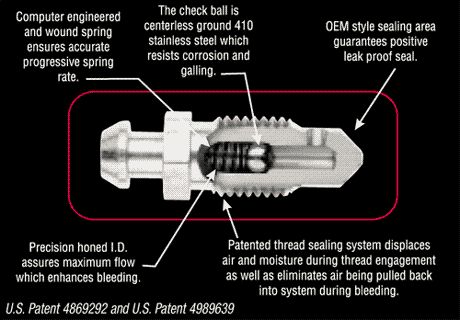| Author | Message | ||
Coastrambler |
Hey, What's skinny on Speed Bleeder's? It's not an item I'm familiar with. | ||
Stevel |
Speed bleeders are devices that provide a steady vacuum to the bleed nipple. When the bleeder is opened, the vacuum is transferred to the master cylinder fluid chamber when the master cylinder piston is in its rearward position opening up the fill port to the oil from the storage chamber to the bleed nipple. In this position, the constant vacuum of the device will draw fresh fluid through the system eliminating any air and debris trapped along the way. This flow stops only when you close the bleed nipple. The device eliminates the need to build pressure with the master cylinder and then venting the pressure and fluid at the bleed nipple. However, there are good ones and bad ones and the difference is huge. I made my own by using a battery powered stomach evacuation pump. These pumps create a vacuum in a plastic container, which I then connect to the bleed nipple. These stomach pumps have a rheostat that controls the level of vacuum in the jar. This makes bleeding a system super fast and allows you to see the debris and air bubbles arriving in the jar. | ||
Stimbrell |
Also used to describe this.  | ||
Stevel |
One other point. My vacuum pump will not produce enough vacuum to overcome the spring pressure on the check ball of Stimwell's speed bleeder. With this type of bleeder valve you must use the the master cylinder piston to pressurize the system. The advantage of a standard bleeder is for not only fast air bleeding, but system flushing as well. Remember Dot 3 and Dot 4 brake fluid is hygroscopic and will pick up moisture over time requiring periodic fluid changes. Stimwell's example does not allow fast flushing. | ||
Stevel |
I guess my explanation of this subject is incomplete without stating the advantage of Stimwell's example. It will theoretically prevent the re-ingestion of air if the master cylinder piston moves rearward before the bleed valve is closed. This is of course incorrect bleed procedure, but that is what the the check ball is supposed to prevent. That will only happen though if the threads are not leaking. Over time and use the thread seals do leak and will introduce re-ingested air. So be careful with these. Your hand will get real tired real soon and you will never get rid of the air. | ||
Shoggin |
Buy the name brand "Speed-Bleeders" they are well built, do the job just fine and have a sealant on the threads already. | ||
Livers |
I've used them for years. The thread leaking air is a myth. |